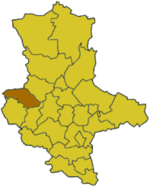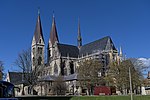Langenstein-Zwieberge
1944 establishments in Germany1945 disestablishments in GermanyBuchenwald concentration campHalberstadt

The Langenstein-Zwieberge was a concentration camp, an under-camp of the Buchenwald concentration camp. More than 7000 prisoners from 23 countries were imprisoned there between April 1944 and April 1945. The camp was situated in the village of Langenstein, Saxony-Anhalt, which has since been absorbed into the town of Halberstadt.
Excerpt from the Wikipedia article Langenstein-Zwieberge (License: CC BY-SA 3.0, Authors, Images).Langenstein-Zwieberge
Vor den Zwiebergen,
Geographical coordinates (GPS) Address Phone number Website Nearby Places Show on map
Geographical coordinates (GPS)
| Latitude | Longitude |
|---|---|
| N 51.844444444444 ° | E 11.023333333333 ° |
Address
Infozentrum Gedenkstätte Zwieberge
Vor den Zwiebergen 1
38895
Saxony-Anhalt, Germany
Open on Google Maps








